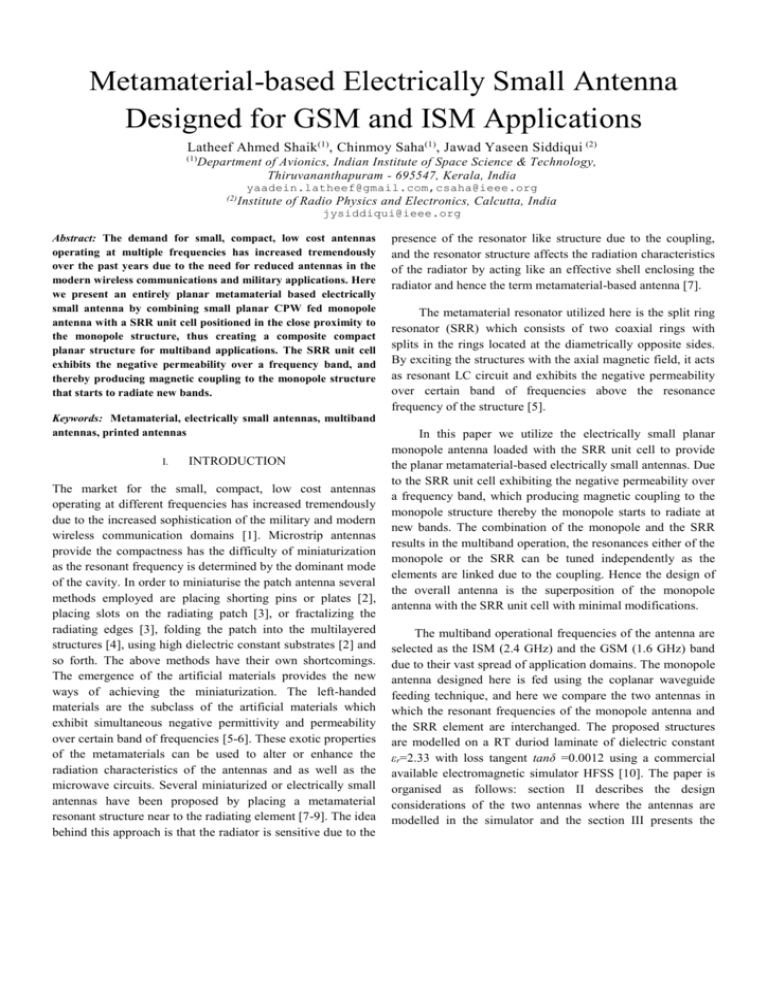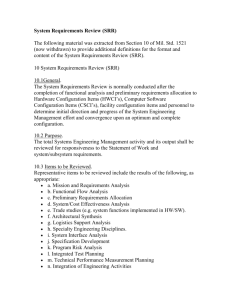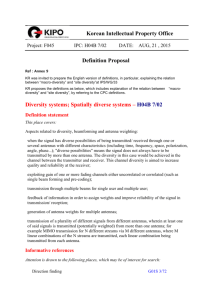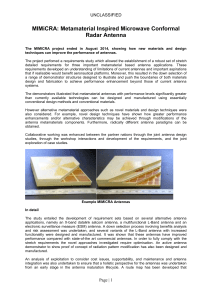FULL PAPER
advertisement

Metamaterial-based Electrically Small Antenna Designed for GSM and ISM Applications Latheef Ahmed Shaik(1), Chinmoy Saha (1), Jawad Yaseen Siddiqui (2) (1) Department of Avionics, Indian Institute of Space Science & Technology, Thiruvananthapuram - 695547, Kerala, India yaadein.latheef@gmail.com,csaha@ieee.org (2) Institute of Radio Physics and Electronics, Calcutta, India jysiddiqui@ieee.org Abstract: The demand for small, compact, low cost antennas operating at multiple frequencies has increased tremendously over the past years due to the need for reduced antennas in the modern wireless communications and military applications. Here we present an entirely planar metamaterial based electrically small antenna by combining small planar CPW fed monopole antenna with a SRR unit cell positioned in the close proximity to the monopole structure, thus creating a composite compact planar structure for multiband applications. The SRR unit cell exhibits the negative permeability over a frequency band, and thereby producing magnetic coupling to the monopole structure that starts to radiate new bands. Keywords: Metamaterial, electrically small antennas, multiband antennas, printed antennas I. INTRODUCTION The market for the small, compact, low cost antennas operating at different frequencies has increased tremendously due to the increased sophistication of the military and modern wireless communication domains [1]. Microstrip antennas provide the compactness has the difficulty of miniaturization as the resonant frequency is determined by the dominant mode of the cavity. In order to miniaturise the patch antenna several methods employed are placing shorting pins or plates [2], placing slots on the radiating patch [3], or fractalizing the radiating edges [3], folding the patch into the multilayered structures [4], using high dielectric constant substrates [2] and so forth. The above methods have their own shortcomings. The emergence of the artificial materials provides the new ways of achieving the miniaturization. The left-handed materials are the subclass of the artificial materials which exhibit simultaneous negative permittivity and permeability over certain band of frequencies [5-6]. These exotic properties of the metamaterials can be used to alter or enhance the radiation characteristics of the antennas and as well as the microwave circuits. Several miniaturized or electrically small antennas have been proposed by placing a metamaterial resonant structure near to the radiating element [7-9]. The idea behind this approach is that the radiator is sensitive due to the presence of the resonator like structure due to the coupling, and the resonator structure affects the radiation characteristics of the radiator by acting like an effective shell enclosing the radiator and hence the term metamaterial-based antenna [7]. The metamaterial resonator utilized here is the split ring resonator (SRR) which consists of two coaxial rings with splits in the rings located at the diametrically opposite sides. By exciting the structures with the axial magnetic field, it acts as resonant LC circuit and exhibits the negative permeability over certain band of frequencies above the resonance frequency of the structure [5]. In this paper we utilize the electrically small planar monopole antenna loaded with the SRR unit cell to provide the planar metamaterial-based electrically small antennas. Due to the SRR unit cell exhibiting the negative permeability over a frequency band, which producing magnetic coupling to the monopole structure thereby the monopole starts to radiate at new bands. The combination of the monopole and the SRR results in the multiband operation, the resonances either of the monopole or the SRR can be tuned independently as the elements are linked due to the coupling. Hence the design of the overall antenna is the superposition of the monopole antenna with the SRR unit cell with minimal modifications. The multiband operational frequencies of the antenna are selected as the ISM (2.4 GHz) and the GSM (1.6 GHz) band due to their vast spread of application domains. The monopole antenna designed here is fed using the coplanar waveguide feeding technique, and here we compare the two antennas in which the resonant frequencies of the monopole antenna and the SRR element are interchanged. The proposed structures are modelled on a RT duriod laminate of dielectric constant εr=2.33 with loss tangent tanδ =0.0012 using a commercial available electromagnetic simulator HFSS [10]. The paper is organised as follows: section II describes the design considerations of the two antennas where the antennas are modelled in the simulator and the section III presents the results and the discussion on the electrically small criteria of the antennas. II. PROPOSED ANTENNA DESIGN The proposed antennas are presented in Fig. 1. The antennas are names as J-antenna and L-antenna because of the shape of the feed used in the design. Here the monopole antenna is fed using coplanar feeding technique and the centre strip is extended to form the feed. The resonance frequency of the monopole is determined by the length of the feed above the ground plane i.e., it resonates when its length is closer to λ/4, the bending of the feed may slightly shift the resonance frequency and coming to the metamaterial resonator circuit, the resonance frequency of the SRR is computed by the rigorous calculations presented in [11]. (a) J-Antenna Figure 2: represents the square split ring resonator. The grey shade indicates substrate and the copper shade represents the metallization. For the J-Antenna the SRR dimensions are: rext = 5mm, c = 0.6mm, d = 0.4 mm, g = 0.4 mm. For the L-Antenna the SRR dimensions are given as: rext = 6.5 mm, c = 0.8mm, d = 0.8mm, g = 0.5mm. The negative permeability of the SRR element can be shown by the procedures described in [12-14], which are not shown here. The SRR exhibits the magnetic resonance, and hence a negative permeability region, acting as a metamaterial sample. We exploit this property to enhance the radiation characteristics of the antenna by disposing this resonator element in the vicinity of the monopole so that it gets magnetically coupled to it and thereby the composite structure radiate multiband. The inclusion of the SRR into he antenna slightly affects the resonance frequency of it, which give the advantage of treating the antenna and the SRR as the individual elements. Some fine tuning is done to bring back the shift in the resonance frequency. The antenna are simulated on RT duriod laminate of dielectric constant εr = 2.33 with loss tangent tan δ = 0.0012 with height of the substrate as h = 1.575mm and the metallization thickness as 35micron. In the J-antenna case the monopole is designed at the 1.6 GHz and the corresponding SRR at 2.4 GHz, whereas in the case of the L-antenna the monopole is designed at the 2.4 GHz and the SRR at 1.6 GHz. The outer dimensions of the antenna are kept the same to compare the compactness of the antenna. III. (b) L-Antenna Figure 1: CPW fed strip monopole antenna loaded with SRR in proximity of the feed (a) J-Antenna, (b) L-Antenna. The dimensions are: L = 20mm, a = 50mm, b = 50mm, W = 0.3mm, S = 5mm, L1 = 18.4mm, L2 = 13mm, L3 = 13.4mm, x = 1mm, y = 1.3mm, L4 = 21mm, L5 = 15mm, x1 = 1mm, y1 = 1.2mm, t = 0.035mm and h= 1.575mm. The dimensions of the respective SRRs are presented in the Fig. 2 caption. SIMULATED RESULTS We have plotted the reflection coefficient of the monopole antennas with and without the SRR in Fig 3, which illustrates that the antennas resonance is slightly altered by the inclusion of the SRR. In the Fig. 3(a), we can observe the reflection coefficient of the J-antenna where the structure radiates at two different frequencies and the lower resonance at 1.6GHz corresponds to the monopole and the upper resonance at 2.4GHz to the SRR. In the absence of the SRR the antenna resonates at single frequency. The higher order mode at 4.8GHz is created in the composite antenna case. In the monopole alone case higher order mode is present but the strength of it is poor, coming to the composite case the interaction between the SRR and the monopole has strengthened the higher order mode. Similarly the Fig. 3(b), represents the reflection coefficient of the L-antenna where the lower frequency at 1.6GHz corresponds to the monopole antenna and the upper frequency to the SRR at 2.4 GHz. One another point to be noted is that the matching bandwidth (-10 dB) of the SRR is greater in the case of the J-antenna as the SRR interacts with more length of the monopole when compared to the L-antenna. With SRR Without SRR 0 0 330 30 -2 -4 300 60 -6 -8 -10 270 90 -8 -6 -4 240 120 -2 210 0 150 180 The radiation patterns of the composite monopole and the monopole alone in both the planes are presented in the Fig. 4. (a) With SRR Without SRR 0 S11 , dB 0 0 -5 -5 -10 -10 -15 330 30 300 60 -20 -15 270 90 -20 -20 -15 Monopole with SRR Monopole alone -25 -10 -30 240 120 -5 0 1 2 3 4 5 6 0 210 150 180 Frequency, GHz (a) (b) 0 Figure 4: Radiation pattern of the J-antenna at the lower resonance frequency of the composite antenna i.e., 1.6 GHz (a) indicates the field pattern in the XZ plane (b) indicates the field pattern in the XY plane -5 S11, dB -10 -15 -20 Monopole with SRR Monopole alone -25 -30 -35 0 1 2 3 Frequency, GHz (b) 4 5 6 The radiation pattern of the monopole is not affected by the inclusion of the SRR, as observed in the Fig. 4. Similarly the radiation pattern of the L-antenna can be plotted and verified that the radiation patterns is slightly altered with the inclusion of the SRR and hence the radiation pattern of the Lantenna is not included here. The radiation patterns are as expected exhibiting omni-directional in one plane and directional radiation pattern in the other. As a thumb rule the antenna is said to be electrically small when the size of it is less than λ/10, this measure of the Figure 3: Reflection coefficient of (a) J-antenna (b) L-antenna. In both the figures the reflection coefficient is plotted for both the composite case as well specifying is not stringent, and hence the theoretical Chu limit as the monopole alone. is used to specify the compactness of the antenna ([7], [1517]). To specify the antenna as electrically small antenna, we have to calculate the quality factor Q of the antenna and compare how close to the Chu limit. To compute the Q value of the system at the resonance frequency f0, the following expressions are used: 2 𝑄𝑉𝑆𝑊𝑅 (𝜔0 ) = 𝑄𝑐ℎ𝑢 (𝜔0 ) = 𝐹𝐵𝑊𝑉𝑆𝑊𝑅 (𝜔0 ) 1 𝑘𝑎 𝑄𝑟𝑎𝑡𝑖𝑜 (𝜔0 ) = 1 + (𝑘𝑎)3 (1) (2) 2 𝐹𝐵𝑊𝑉𝑆𝑊𝑅 (𝜔0 )×𝑄𝑐ℎ𝑢 (𝜔0 )×𝑅𝐸 (3) REFERENCES [1] John L. Volakis, Chi-Chih Chen, Kyohei Fujimoto, Small Antennas, New York; Tata McGraw hill, 2010. [2] K. L. Wong, Compact and Broadband Microstrip Antennas, Hobokken, NJ; Wiley 2002. [3] C. A. Balanis, Modern Antenna Handbook, Hoboken, NJ; Wiley, 2010. [4] R. Chair, K.M. Luke, and K. F. Lee, “Miniature multi-layer shorted patch antenna,” Electron. Lett, vol. 36, no. 1, pp. 3-4, 2000. [5] J. B. Pendry, A. J. Holden, D. J. Robbins, and W. J. Stewart, “Magnetism from conductors and enhanced nonlinear phenomena,” IEEE Trans. Microw. Theory Tech., vol. 47, no. 11, pp.2075-2084, Nov. 1999. where the FBWVSWR(ω0) is the 3-dB fractional bandwidth at the resonance frequency, k is the wave number, a is the maximum dimension of the antenna and RE is the radiation efficiency. When the value of the Qratio is equal to or less than one we say the antenna as an electrically small antenna. Here by considering the antennas fully enclosed by a hypothetical sphere of diameter equal to the maximum dimension of the composite antenna structure. As the resonances are closely, it is advised to consider the 10-dB bandwidth to estimate the Qratio [17]. The Qratio for J-antenna is 3.816 when the 3-dB bandwidth is taken in consideration for calculation and 6.86 when the 10-dB is taken into account. The drastic change in the Qratio is due to the change in the fractional bandwidth. Whereas for the L-antenna we cannot utilize the 3-dB bandwidth as the response does not cross 3-dB and hence by taking into 10-dB bandwidth consideration the Qratio is 29.55. [6] D. R. Smith, W. J. Padilla, D.C. Vier, S.C. Nemat-Nasser, and S. Schultz, “Composite medium with simultaneously negative permeability and permittivity,” Phys. Rev. Lett., vol. 84, no. 18, pp. 4184-4187, 2000. The value of Qratio for L-antenna is quite high when compared to that of the J-antenna, this is as anticipated since the J-antenna fills the radiating sphere more efficiently when compared to the L-antenna. The values obtained for the case of CPW fed J-antenna is better than those obtained in [], and while noting that as the proposed structure is planar, hence the large volume of the radian sphere cannot be exploited, the amount of compactness achieved is satisfactory. [12] D. R. Smith, D. C. Vier, TH. Koschny, and C. M. Soukoulis, “Electromagnetic parameter retrieval from inhomogeneous metamaterials,” Phys. Rev., E 71, pp-036617, 2005. IV. CONCLUSION We have presented the planar electrically small antennas which utilize the concept of the metamaterials, and the multi band functionality is achieved. The resonances of the monopole and the SRR are independent of each other and hence can be manipulated individually thereby providing a great degree of freedom for the selection of other frequencies. The J-antenna achieved much compactness as the radiating part is closer to the boundary of the radiating sphere and the resonators in the interior. [7] A. Erentok and R. W. ZIolkowski, “Metamaterial-inspired efficient electrically small antennas,” IEEE Trans. Antennas Propag., vol. 56, no. 3, pp. 691-707, Mar. 2008. [8] D. K. Ntaikos, N. K. Bourgis, and T. V. Yioultsis, “Metamaterial-based electrically small multiband planar monopole antennas,” IEEE Ants. and Wireless Propag. Lett., vol. 10, no. 10, pp. 963-966, Sept. 2011 [9] H. Cherbi, F. Ghanem and H. Kimouche, “Metamaterial-based frequency reconfigurable antenna,” Electronic Lett., vol. 49, no. 5, Feb. 2013. [10] HFSS: High Frequency Structure Simulator, V. 15, Ansoft Corp. [11] R Marques, F Martin, and M sorolla, Metamaterials with Negative Parameters : Theory, Design and Microwave Applications, New Jersey, John Wiley & Sons, 2008. [13] X. Chen, T. M. Grzegorckzky, B. I. Wu, J. Pacheao and J. Kong, “Robust method to retrieve the constitutive effective parameters of metamaterials,” Phys. Rev., E 70, pp-016608, 2004. [14] R. Hedge, Z. Szabo, G. Park, E. P. Li, “A unique extraction of metamaterial parameters based on Kramers Kronig relationship,” IEEE Trans. Microw. Theory Tech., vol. 58, no. 10, pp. 2647-2653, 2010. [15]H. A. Wheeler, “Small antennas,” IEEE Trans. Antennas Propag., vol. 23, no. 4, 1975. [16] R. W. Ziolkowski and A. Erentok, “At and below the chu limit: passive and active broad bandwidth metamaterial-based electrically small antennas,” Microw. Antennas Propag., vol. 1, no. 1, pp. 116-128, 2007. [17] A. D. Yaghjian and S. R. Best, “Impedance, bandwidth, and Q of antennas,” IEEE Trans. Antennas Propag., vol. 53, no. 4, pp.-1298-1324, 2005.






